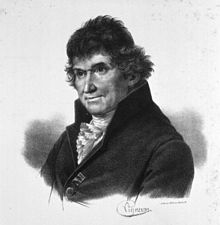| François Chaussier | |
|---|---|
 | |
| Born | (1746-07-02)2 July 1746 Dijon |
| Died | 19 June 1828(1828-06-19) (aged 81) |
| Nationality | French |
| Scientific career | |
| Fields | anatomist |
François Chaussier (2 July 1746 – 19 June 1828) was a French anatomist who was a native of Dijon. His name is associated with the Prix Chaussier (Chaussier Prize).
He studied medicine in Besançon, later returning to Dijon, where he worked as a hospital physician. During this time he performed pioneer research in the field of forensic medicine. In 1780 he became a professor of anatomy.
In 1794 he was summoned to Paris by Antoine-François Fourcroy (1755–1809), being given the responsibility of drafting a report on the establishment of learning institutions of health. This report was presented to the National Convention on 27 November 1794.
Afterwards, Chaussier remained in Paris where he became a professor at the École Polytechnique, and a chief obstetrician at the Paris Maternité, where he was a colleague of Jean-Louis Baudelocque (1745–1810). In 1822 Chaussier was elected as a member of the Académie des sciences.
Chaussier is credited for introducing a procedure for revival of "near-dead" newborns. He also performed a descriptive survey of all muscles in the human body, and developed a new system of designation for muscles. He also conducted early investigations of neuralgia.
Associated eponyms
- "Chaussier's areola": A ring of indurated tissue surrounding the lesion of cutaneous anthrax.
- "Chaussier's line": Anteroposterior raphe of the corpus callosum.
- "Chaussier's sign": Severe pain in the epigastric region, a premonitory symptom of eclampsia.
Selected publications
- Tables synoptiques d'anatomie (Synoptic tables of Anatomy); (1799-1816)
- Manuel médico-légal des poisons (Handbook of poisons in forensic medicine); (1824)
- Recueil de mémoires, consultations, et rapports sur divers objets de médecine légale (Collection of memoirs, consultations, and reports on various objects of forensic medicine); (1824)
- Mémoire médico-légal sur la viabilité de l'enfant naissant (Memoir of forensic medicine on the viability of childbirth); (1826)
References
- This article incorporates translated text from an equivalent article at the French Misplaced Pages.
- Benkhadra, M; Salomon C; Trouilloud P (Dec 2008). "François Chaussier (1746-1828). A vision of the anatomic nomenclature based on education". Morphologie: Bulletin de l'Association des Anatomistes. 92 (299). France: 195–8. doi:10.1016/j.morpho.2008.08.001. ISSN 1286-0115. PMID 18829368.
- Stofft, H (1997). "New born's apparent death (1781-1806) through François Chaussier's Work". Histoire des sciences médicales. 31 (3–4). FRANCE: 341–9. ISSN 0440-8888. PMID 11625222.
- Online Medical Dictionary, Definition of Eponyms